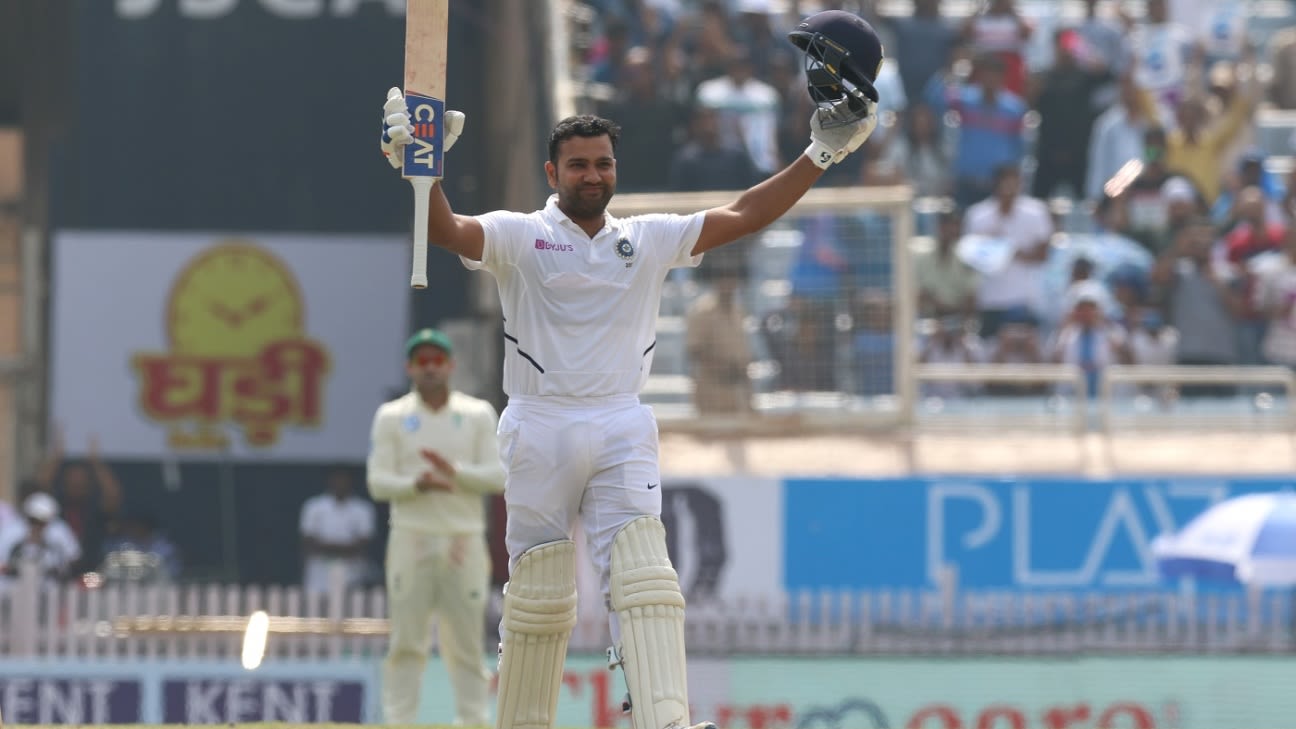
Rohit Sharma is all but likely to partner Mayank Agarwal at the top of the order should he be cleared to fly for the Tests in Australia, but he isn't too fussed over his batting position.
"I will tell you the same thing that I have told everyone all this while. I will be happy to bat wherever the team wants me to, but I don't know if they would change my role as an opener," Sharma told PTI.
Having started his career in the middle order, Sharma transitioned to become a Test opener during India's home series against South Africa last year and found immediate success. He topped the series charts with 529 runs in four innings, including three centuries.
The combined tally of 525 runs between Sharma and Agarwal across both innings of the first Test in Vizag is a national record, bettering the 414 by Sunil Gavaskar and Chetan Chauhan. Along the way, Sharma also became the first Indian to score two centuries in his first Test as an opener, having slammed 176 and 127.
After that, he opened just twice in the subsequent series against Bangladesh before an injury ruled him out of India's most-recent Test series in New Zealand, which they lost 2-0 in February.
"I am sure the guys already in Australia must have figured out what are the options when Virat [Kohli] leaves and who are the guys who will open the innings," he said. "Once I reach there, I will probably have a clearer idea of what's going to happen. I will be okay to bat wherever they want."
Sharma wasn't included in the original Test squad for Australia due to a hamstring injury he suffered during the recent IPL in the UAE, which forced him to miss four games for the Mumbai Indians. He was, however, added to the Test squad once it emerged that his injury wasn't that bad. He is currently at the National Cricket Academy in Bengaluru for rehabilitation. On Saturday, he said the "hamstring is feeling absolutely fine, just started the process of getting it nice and strong".
ALSO READ: Ian Chappell: Australia-India series might hinge on who makes better selections
Sharma had featured in just two of the four Tests on India's previous tour to Australia in 2018-19, scoring a highest of 63 not out with India looking for a declaration in the first innings of the third Test in Melbourne. But having been on every tour to Australia since 2008 - where he first burst into the ODI scene with a match-winning partnership with Sachin Tendulkar in the first of the tri-series finals in Sydney - he felt the surfaces are a lot more batting-friendly now.
"We talk about bounce, but except for Perth, over the past few years, the other grounds (Adelaide, MCG, SCG), I don't think have that much bounce," he said. "Nowadays, especially while opening the batting, I will have to think about not playing the cut or pull shots and focus on playing in the 'V' and as straight as possible."
Among the better players of the pull shot currently, Sharma isn't too perturbed about talks around having to deal with the short-pitched stuff from Australia's pace attack of Mitchell Starc, Josh Hazlewood and Pat Cummins.
"We talk about bounce on Australian tracks. But tell me how many people got out on bouncers during the last series?" he asked. "When we played in Perth in 2018-19, it was Nathan Lyon who got eight wickets including a five-for. In Australia, half the job is done if you can start well upfront.
"With new ball, whoever bowls - whether it's Starc, Cummins or Hazlewood - they will obviously pitch it up, swing the ball and the bouncer would be used sparingly. They would try to ensure with the new ball that they would get some movement off the air or off the pitch. With the new ball, everybody in the world loves to bowl up and send down one odd bouncer here and there. So majority of the deliveries will be up and towards the bat and not short."
Sharma admits playing red-ball cricket after more than a year would be a challenge, but the key is to not think too far ahead.
"It's going to be challenging. In general, international cricket is never easy, whichever format it is," he said. "When you had such a long layoff [from international cricket], it becomes all the more difficult. So I would be focusing on basics of red-ball cricket and then you can top up with other things. That's how I would like to take it forward. You can't just jump the gun and think too far ahead."















 Phone: (800) 737. 6040
Phone: (800) 737. 6040 Fax: (800) 825 5558
Fax: (800) 825 5558 Website:
Website:  Email:
Email: 






